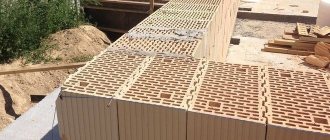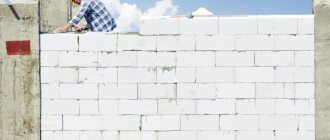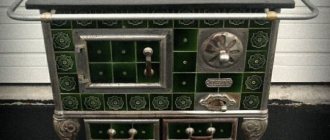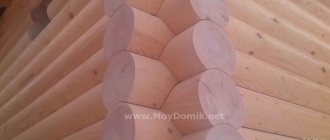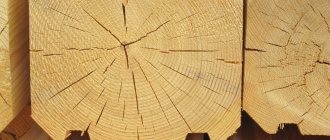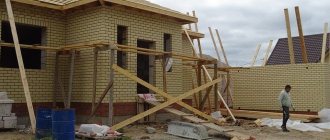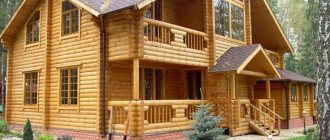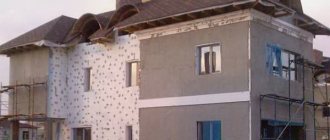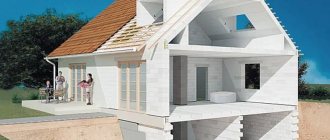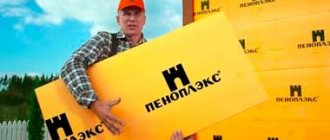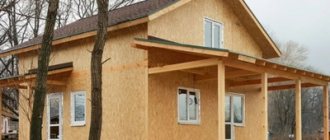- Features of building houses from ceramic blocks
- Characteristics of ceramic blocks for building a house
- Pros and cons of houses made of warm ceramics
- Comparison with other materials
- Types of ceramic blocks for building a house
- Summary
Ceramic blocks for construction in Russia began to be used only a few years ago, but already during this time their advantages and styles have become obvious both to construction companies and to home owners.
The new material is characterized by excellent thermal insulation qualities, large dimensions (which greatly increases the speed of construction) and an attractive price, but is not without its drawbacks. To form your own opinion about the so-called warm ceramics, we recommend that you get to know the material better.
Features of building houses from ceramic blocks
Warm ceramics is an artificial stone made from clay. Moreover, each block has a complex shape and is used for the construction of various structures. The material is equally well suited for the construction of walls, partitions and any other fences.
The size of each large-format ceramic block is approximately 10-15 standard bricks. They can be used for the construction of load-bearing walls of buildings no more than 5 floors high and provide structures with high strength, optimal sound and heat insulation.
Thanks to their high porosity, walls made of warm ceramics can “breathe,” which helps maintain a comfortable microclimate in the house.
The pores of the blocks are formed by adding special additives to the clay during production (for example, sawdust). During firing of the material, the additives burn out, leaving very small pores filled with air.
Thanks to this, the blocks have excellent thermal insulation properties and remain relatively light.
Modern ceramic block: what is it?
By definition, ceramic blocks are building blocks that come in a variety of sizes. They are made from low-melting clay, their average voidness is about 50% (but can be more). The diameter of microvoids is approximately 3 mm, and they appear as a result of the addition of porosizers to the clay. These are flammable substances that burn out when the product is fired - and pores remain in their place.
The more porosizers in the clay, the warmer the blocks are, but the lower their strength. At the same time, both lightweight and durable blocks require strict adherence to technology, so the plant for their production should be selected as carefully as possible.
There are different sizes of ceramic blocks. They are tied to the size of a normal format (NF) brick: 250x120x65 mm. The most popular sizes of ceramic block on the Russian construction market have the following dimensions.
- 10.7 NF (38th), 380x250x219 mm.
- 12.4 NF (44th), 440x250x219 mm.
- 14.3 NF (51st), 510x250x219 mm.
The strength of the block can be from M25 to M200. To build load-bearing walls, you need strength starting from M100 (this is achieved by introducing special additives into the material). More fragile blocks (from M30 to M50 in strength) can be used as insulation, lining strong walls with them.
On top there is an external cladding made of low-porous brick (half a brick). Photo brick24.ru
Characteristics of ceramic blocks for building a house
Each building material has many characteristics that determine its technical and operational qualities. They depend on the raw materials and technology used in production.
Speaking about warm ceramics, we can highlight several such features:
- thermal conductivity - from 0.13 to 0.2 W/(mK);
- water absorption - 14%;
- frost resistance - at least 50 cycles;
- strength grade - from M75 to M150;
- good sound insulation;
- highest level of fire resistance.
Ceramic blocks have the shape of a parallelepiped.
Material composition and production technology
The following materials can be used as materials used in the production of ceramic blocks:
- clay
- siliceous rocks,
- industrial waste (coal, ash),
- mineral supplements,
- water.
Upon receipt of the material, the feedstock is subjected to the following stages of processing:
- clay and other components of the mixture are thoroughly crushed;
- the resulting mass is moistened and mixed;
- the resulting solution is poured into molds;
- at the next stage, the products are dried in molds;
- After drying, the products are annealed.
Pros and cons of houses made of warm ceramics
All building materials on the market have a number of advantages and disadvantages that must be taken into account when choosing and using.
Warm ceramics quickly gained high popularity in Russia, as it has a number of important advantages:
- Optimal thermal insulation. Due to their porosity, the blocks are suitable for the construction of load-bearing and self-supporting walls without the use of additional insulation.
- Large selection of standard sizes. Modern manufacturers produce a complete list of blocks required in size for the manufacture of any walls and partitions.
- Vapor permeability. A high level of vapor permeability is ensured due to the presence of pores in the artificial stone.
- Big size. Allows you to significantly speed up the construction procedure of any building.
- Ease. Reduces the cost of necessary equipment for construction.
- Environmental friendliness. Only natural, environmentally friendly and safe materials are used for production.
- Durability. The service life is at least 100 years.
Naturally, each material has not only pros, but also cons.
Disadvantages of warm ceramics:
- Fragility. Relatively low strength (compared to conventional brick) is noted by many builders. The porous structure makes the material poorly resistant to shock loads.
- High water absorption. To prevent moisture from damaging the material, the first layer of blocks must be protected with waterproofing.
- Inaccurate dimensions. Some irresponsible specialists do not carefully monitor compliance with the promised standards for the size of manufactured products, hence the possible difference in length and width between individual products of up to 4-5 mm.
- Difficult to install. The fragile material requires careful handling not only during construction, but also when performing interior finishing and repair work.
- High consumption of solution. Some of the solution flows into the holes of warm ceramics, which increases its consumption and leads to an increase in the estimate. The problem can be mitigated by using special plastic mesh that is used to lay each row of masonry.
Warm ceramics have disadvantages, but if they are taken into account, then during the construction and operation of the building the necessary actions can be taken so that they do not cause increased financial costs and reduced comfort.
Disadvantages of porous stones
Like any other building material, ceramic blocks have a number of disadvantages, including :
- Relatively expensive. Construction from them will cost less than from brick, but more expensive than from other materials, for example, from gas or foam blocks.
Low resistance to dynamic loads.
The end parts are considered especially vulnerable. Therefore, it is not recommended to build with them in regions with increased seismological activity.- Fragility. The material must be handled carefully. Increased fragility makes transportation difficult and requires special care.
- The need for strict adherence to construction technologies. Deviations are not allowed. Violations during the masonry process lead to the entire structure collapsing or cracking in the near future. It is not recommended to start building walls made of ceramic blocks without experience.
- The need to use a special cutting tool. Most often, a grinder is used for this. It will not be possible to split the block like a brick.
- Difficulties with attaching classic anchors. In order to hang furniture or equipment on the wall, you will have to buy special equipment.
- Restrictions on number of storeys. It is not recommended to construct buildings higher than 2 floors from blocks.
- The need for exterior finishing, for which it is recommended to use facing bricks.
Comparison with other materials
To decide on the possibility of using a certain material, it may not be enough to just consider the disadvantages of houses made of warm ceramics. Therefore, we will compare ceramic blocks with other popular materials and try to identify the best one.
Warm ceramics and aerated concrete
To objectively name the best material, it is necessary to compare their main technical and operational characteristics:
- Strength. Ceramic blocks are more durable and can withstand heavy loads. They can withstand pressures of up to 15 MPa, while aerated concrete products are sometimes damaged under pressure of about 5 MPa. To avoid cracking of aerated concrete, builders often use a special reinforcing belt.
- Frost resistance. If you compare materials by frost resistance (the number of cycles they can withstand), it will not be possible to identify a winner. Both materials can last more than 50 cycles, but it must be taken into account that aerated concrete needs more careful protection from moisture. If there is any amount of water in the blocks, its freezing in winter can lead to premature cracking of the wall material.
- Thermal insulation. In terms of thermal insulation coefficient, aerated concrete has almost no equal: up to 0.12 W/m*K. Ceramic blocks have slightly worse performance: 0.15-0.28 W/m*K.
- Soundproofing. In terms of the material’s ability to protect interior spaces from extraneous noise, ceramic blocks and aerated concrete are almost equal. The first can absorb noise up to 53 dB, and the second - no more than 45 dB.
- Difficulty of processing. Unlike warm ceramics, aerated concrete is processed very easily using the most accessible materials: a regular saw, drill, etc. To cut a ceramic block, you need a grinder with a diamond wheel, and it will not be possible to make grooves in it at all, since this will lead to the opening of internal voids.
- Price. In terms of price, aerated concrete also beats warm ceramics.
- Overall durability. In Europe, ceramic blocks are often chosen due to the very long service life of the material. A house made of warm ceramics can easily last more than 100 years. Aerated concrete is not so durable, although its service life is estimated at many decades. The only problem is that high humidity can greatly reduce the service life of aerated concrete.
In general, both materials have excellent technical and operational characteristics, and are therefore well suited for the construction of private houses. They are energy efficient, safe and durable.
In some respects, warm ceramics are better than aerated concrete, but the latter is more suitable for low-rise construction with limited budgets.
Warm ceramics and bricks
The second building material with which warm ceramics are often compared is traditional brick, which has been successfully used for centuries to build a wide variety of structures.
Comparison of main characteristics:
- Composition of the material. Bricks and ceramic blocks are made primarily from clay, to which sawdust, wood chips or straw are added to create warm ceramics.
- Dimensions. Ceramic blocks are much larger than bricks, so building houses with them is faster than with traditional bricks. However, this leads to difficulties when creating complex architectural forms, such as arches and cornices.
- Speed of building a house. To build an object of the same size using ceramic blocks, you need to spend 3-4 times less time than using bricks. This makes the use of warm ceramics more economically profitable, since you will have to pay less time for hired builders.
- Strength. Brick is considered a more durable material than ceramic blocks. The strength class of the first can reach up to M300, while warm ceramics are no stronger than M150. This difference is important only in the construction of multi-story structures that require strength class M200 and higher. For the construction of a cottage, the reliability of ceramic blocks is quite sufficient.
- Thermal conductivity. In terms of thermal insulation characteristics, warm ceramics outperform brick: 0.15 W/m*C versus 0.35–0.41 W/m*C for ceramic and 0.81 W/m*C for sand-lime brick.
- Frost resistance. In terms of frost resistance characteristics, ceramic blocks and bricks are the same; they can withstand approximately the same number of freezing/thawing cycles.
As a result: brick is a more suitable material for multi-story construction. If you need to build a private house, ceramic blocks are preferable.
Reviews about ceramic block
People who have built houses from ceramic blocks and live in them are satisfied with their choice. They indicate that the material most often does not require insulation, since the environment inside is always comfortable . This is talked about both by residents of the central zone and the north of Russia, where winters are always frosty.
They note that ceramics are much more environmentally friendly than gas, foam or cinder blocks. Therefore, living in such houses is not scary even with children. People do not suffer from allergies, insects do not live in the walls. They choose this building material for its durability, safety and comfortable microclimate.
The main disadvantage of ceramic blocks is their high cost compared to analogues.
Reviews can be found here and here.
Experts
An analysis of expert reviews allows us to conclude that they choose ceramic blocks . The reasons for this are simple:
- Ecological cleanliness.
- Low thermal conductivity.
- High energy efficiency.
Experts advise carefully choosing the company from which you will purchase blocks. Choosing an unreliable supplier risks purchasing a defective batch.
Read the discussion of experts on the forums here and here.
Builders
Builders value blocks because they do not need to pour a heavy foundation to build an object. They indicate that the blocks are easy to install, “fit” into the grooves and are securely fastened to each other.
The consumption of masonry mixture is not high , and the seams are thin, which avoids cooling the room.
The disadvantages include the increased fragility of the material, which requires special care when carrying out work.
Builders share their opinions here and here.
Types of ceramic blocks for building a house
There is a wide range of ceramic blocks on the market that vary in size. For convenience, when designating the parameters of one block of warm ceramics, a multiple of the size of a standard brick is used, for example, a 4.5NF ceramic block has a size equal to 4.5 bricks.
The following types of ceramic blocks are most often used in construction:
- 2.1NF;
- 4.5NF;
- 10.7NF;
- 11.2NF;
- 14.3NF.
GOST identifies even more standard sizes of ceramic blocks - 14. This is done to take into account blocks with non-standardized sizes, which are produced by many manufacturers.
There are also two types of blocks according to their purpose:
- Privates. Used for the main masonry of walls.
- Facial. Used for external cladding.
In addition, there are solid and additional blocks. The former are used for laying walls, and the latter for creating corners.
For ease of construction, many manufacturers offer customers ready-made sets of ceramic blocks for construction, which include products of different sizes and purposes.
How the invention of Australian engineers acclimatized in Russia
According to one version, large ceramic blocks with many voids inside were invented by Australian engineers about half a century ago. This wall material meets one of the main needs in our latitudes (despite its southern origin) - it retains heat very well. A large number of air cushions inside the blocks creates many obstacles to the free transfer of heat. Therefore, relatively speaking, the more “holes” in this ceramic “cheese”, the warmer it is.
In size, one large-format porous ceramic block replaces 11-14 standard bricks (depending on the “caliber”). In order for the wall to be strong and the blocks to be held securely, they are now made ribbed - they fit into each other according to the “tenon and groove” principle.
In the first Australian ceramic blocks, the volume of voids reached 50%. Around the beginning of the 21st century, this type of wall material reached our country - factories for its production appeared and houses began to be built. True, according to GOST standards, the air content in them can now reach up to 72%; the dimensions have also changed - they have become larger. Porous ceramics are regulated by the same GOST 230-2012, which we studied in one of the previous articles.
In order for the wall to be strong and the blocks to be held securely, they are now made ribbed - they fit into each other according to the “tenon and groove” principle. Photo russ-kirpich.ru
Importance of solution
Ceramic material will fully perform its functions only if it is laid correctly and the mortar is selected correctly. Otherwise, the interblock seams will facilitate the passage of cold flows and reduce the thermal insulation properties of the material. In addition, an incorrectly chosen or poor-quality solution can “fall” into the voids of the blocks and form gaps between the elements.
